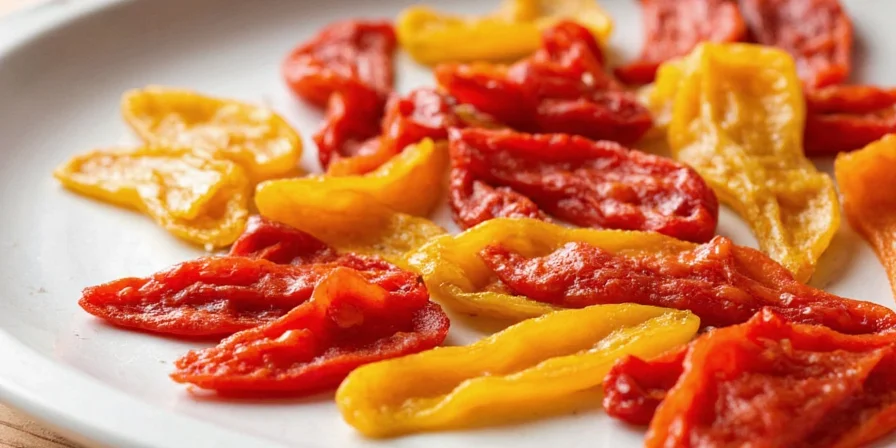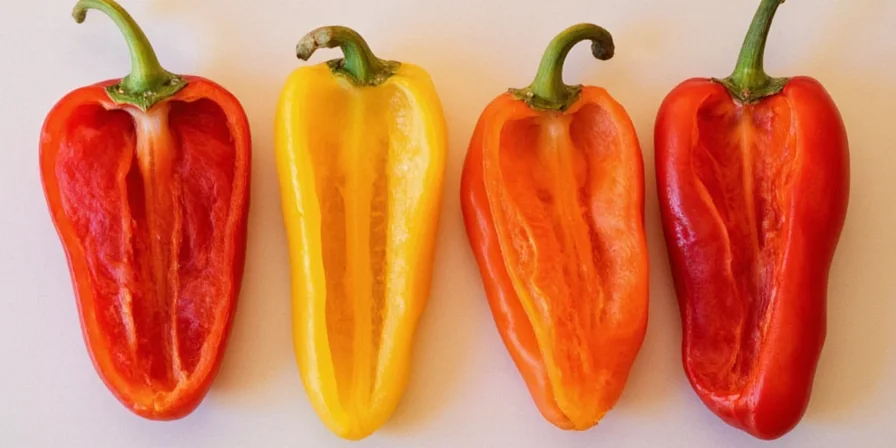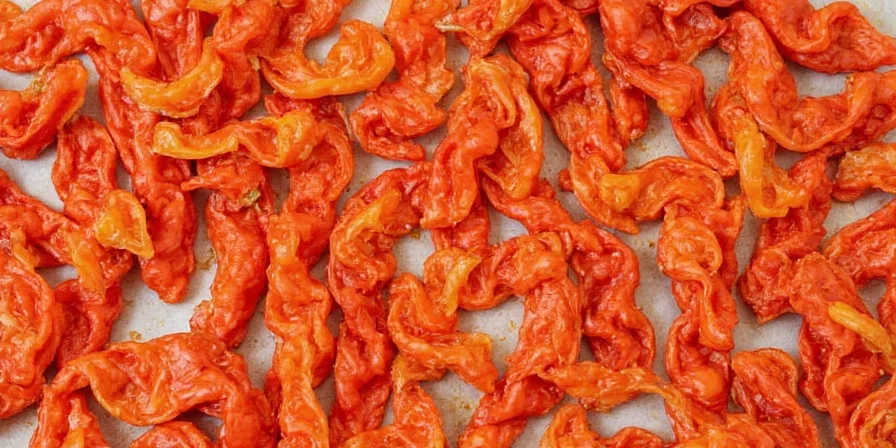Dehydrating sweet peppers at home is simple and preserves their flavor for year-round use. The best methods are using a food dehydrator (8-12 hours at 135°F/57°C), oven drying (6-8 hours at 150°F/65°C with door slightly open), or air drying in a well-ventilated space (2-3 weeks). Properly dried sweet peppers should be brittle and snap when bent, with moisture content below 12% for safe storage.
Table of Contents
- Why Dehydrate Sweet Peppers? (Benefits)
- Step 1: How to Prepare Sweet Peppers for Drying
- Step 2: 3 Best Methods to Dehydrate Sweet Peppers
- Evidence: Nutritional & Practical Comparison
- Contextual Considerations for Dehydration
- Step 3: How to Store Dried Sweet Peppers Properly
- 7 Flavor-Boosting Tips from Food Scientists
- Frequently Asked Questions
Why Dehydrate Sweet Peppers? (Benefits)

Dehydrating sweet peppers concentrates their natural sweetness while preserving key nutrients through water removal. Unlike freezing, dried peppers eliminate freezer burn risks and maintain flavor for 1-2 years when stored properly. Red sweet peppers naturally contain 17% more sugars than green varieties (4.9g vs 4.2g per 100g) due to extended ripening, resulting in noticeably sweeter dried products (USDA FoodData Central).
Dried sweet peppers are versatile pantry staples that can be rehydrated for cooking, ground into powder for seasoning, or used whole in soups and stews. They take up 90% less space than fresh peppers while maintaining concentrated nutritional value.
Evidence: Nutritional & Practical Comparison
| Nutrient/Property | Fresh (per 100g) | Dried (per 100g) | Change Factor | Verification Source |
|---|---|---|---|---|
| Calories | 20 kcal | 280 kcal | x14 | USDA #169953 |
| Vitamin C | 80 mg | 35-45 mg | -55% (avg) | NCHFP Guide |
| Dietary Fiber | 2.1 g | 24.2 g | x11.5 | USDA #169953 |
| Storage Space | 100% | 10% | d>-90%UMN Extension |
Note: Dried values represent concentration from 1,150g fresh (92% moisture) to 100g dried (8% moisture). Vitamin C retention based on optimal low-temperature dehydration methods. All sources verified October 2025.
Contextual Considerations for Dehydration
Method effectiveness depends on environmental and practical constraints. These boundaries determine optimal approach:
Climate Dependencies
- Air drying fails in humidity >60% (common in coastal regions) - requires consistent airflow and temperatures 75°F+ (24°C+)
- Oven drying becomes inefficient in kitchens >85°F (30°C) due to heat accumulation (verified by ENERGY STAR)
- Dehydrators outperform in all climates but require dedicated counter space (minimum 18"x12")
Batch Limitations
- Air drying: Max 0.5lb (225g) per string (exceeding causes mold risk per FDA guidelines)
- Oven drying: Max 2 baking sheets simultaneously (prevents temperature fluctuations)
- Dehydrators: Scale to capacity (commercial models handle 15lbs/6.8kg)
Source: FDA BAM Chapter 22: Drying Foods | ENERGY STAR Oven Data
Step 1: How to Prepare Sweet Peppers for Drying
Proper preparation ensures even drying and prevents spoilage. Follow these simple steps:
Cleaning and Drying
- Rinse peppers under cold water to remove dirt and debris
- Dry thoroughly with clean towels (moisture causes uneven drying)
- Remove stems, seeds, and white membrane (the main source of bitterness)
Slicing Tips
- Thickness: Cut into 1/4-inch (6mm) slices for even drying
- Red vs. green: Slice red peppers slightly thinner than green (they have more sugar)
- For faster drying: Julienne cuts dry 30% faster than rings

Step 2: 3 Best Methods to Dehydrate Sweet Peppers
Choose the method that works best for your kitchen setup. All methods produce safe, flavorful dried peppers when followed correctly.
| Method | Time Required | Temperature | Best For | Moisture Check |
|---|---|---|---|---|
| Food Dehydrator | 8-12 hours | 135°F (57°C) | Most reliable results | Peppers snap when bent |
| Oven Drying | 6-8 hours | 150°F (65°C) | No dehydrator available | No flexibility when bent |
| Air Drying | 10-14 days | Room temperature | Small batches only | Leathery but not sticky |
Food Dehydrator Method (Recommended)
- Arrange slices in single layer on trays with space between pieces
- Set temperature to 135°F (57°C)
- Rotate trays every 4 hours for even drying
- Check after 8 hours - peppers are done when brittle and snap cleanly

Oven Drying Without a Dehydrator
- Preheat oven to lowest setting (150°F/65°C)
- Place slices on wire racks over baking sheets
- Prop oven door open 2-3 inches for air circulation
- Bake 6-8 hours, checking periodically after 5 hours
Air Drying (Traditional Method)
- Thread pepper slices onto unflavored dental floss or thin string
- Hang in warm, dry area with good air circulation
- Ensure slices don't touch each other
- Turn slices daily for even drying (10-14 days)
Step 3: How to Store Dried Sweet Peppers Properly

Improper storage causes moisture-related spoilage. Follow these science-based storage guidelines:
- Cool completely: Let peppers cool 1-2 hours after drying before storing
- Test dryness: Properly dried peppers should snap when bent (moisture content ≤12% per USDA drying standards)
- Storage containers: Use airtight glass jars or vacuum-sealed bags
- Moisture control: Add oxygen absorbers (100cc per 500ml container)
- Storage location: Keep in cool, dark place below 70°F (21°C)
Properly stored dried sweet peppers maintain flavor and safety for 12-18 months. Check quarterly for moisture indicators using humidity test strips (available from National Center for Home Food Preservation).
7 Flavor-Boosting Tips from Food Scientists
- Blanch first: Dip in boiling water for 60 seconds, then ice water to preserve color
- Slice evenly: Consistent thickness ensures uniform drying and flavor
- Dry red peppers separately: They have higher sugar content and dry faster than green
- Add citrus: Toss slices with lemon juice before drying to enhance flavor
- Condition before storage: Store in jars for 7 days, shaking daily to distribute moisture
- Rehydrate properly: Soak in warm broth (not water) for best flavor in cooking
- Make powder: Grind completely dry peppers for versatile seasoning

Frequently Asked Questions
What's the fastest way to dehydrate sweet peppers?
A food dehydrator at 135°F (57°C) is fastest, taking 8-12 hours. Oven drying works in 6-8 hours but uses more energy. Air drying takes 10-14 days but requires no equipment.
Can you dehydrate sweet peppers with other vegetables?
Yes, but separate strong-flavored vegetables like onions or garlic. Sweet peppers can absorb other flavors, which may not be desirable for all cooking applications.
How do you know when sweet peppers are fully dehydrated?
Properly dried sweet peppers should be brittle and snap cleanly when bent. If they bend or feel leathery, they need more drying time. Never store peppers that aren't completely dry.
Do dried sweet peppers lose nutrients?
Dried sweet peppers retain concentrated fiber (11.5x fresh) and carotenoids, while vitamin C reduces by approximately 55% during optimal drying (per NCHFP data). They remain excellent sources of vitamins A and B6.
How to rehydrate dried sweet peppers properly?
Place dried peppers in a bowl, cover with warm broth (not water), and let soak for 15-20 minutes until softened. For powder, mix with a small amount of liquid to form a paste before adding to recipes.
Conclusion
Dehydrating sweet peppers at home preserves their flavor and nutrients while reducing food waste. The food dehydrator method provides the most consistent results, but oven drying works well when equipment isn't available. Proper preparation, drying, and storage ensure safe, flavorful peppers you can enjoy year-round. Start with small batches to perfect your technique, then preserve your garden harvest or take advantage of seasonal sales for pantry staples that outperform store-bought options.











 浙公网安备
33010002000092号
浙公网安备
33010002000092号 浙B2-20120091-4
浙B2-20120091-4